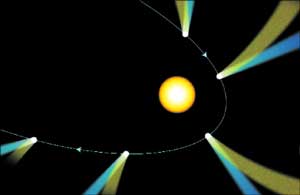Tails of a Comet
As seen in this photo of Comet Hale-Bopp  , comets often develop two types of tails as they round the Sun at perihelion, their closest approach. Stars can be seen through the comet's bright blue ion tail, which is starting to develop some streamers. The yellowish dust tail is equally ethereal. Both tails point away from the Sun, orienting themselves according to where the comet is in relation to the Sun and the charged particles of the solar wind , comets often develop two types of tails as they round the Sun at perihelion, their closest approach. Stars can be seen through the comet's bright blue ion tail, which is starting to develop some streamers. The yellowish dust tail is equally ethereal. Both tails point away from the Sun, orienting themselves according to where the comet is in relation to the Sun and the charged particles of the solar wind  (opposite). (opposite). |
The Sun's strong gravitational pull dooms comets to return again and again to the inner solar system. Each time they lose more mass and shine a bit less brightly. Some comets fizzle after hundreds or thousands of such orbits and drift like small asteroids  among the inner planets. Others split into pieces among the inner planets. Others split into pieces  like poorly packed snowballs if they wander too close to the Sun. Still others plunge into the Sun like poorly packed snowballs if they wander too close to the Sun. Still others plunge into the Sun  and melt in a flash--the ultimate in solar system recycling. and melt in a flash--the ultimate in solar system recycling.
As for Comet Hale-Bopp  , our descendants will see it again in the year 4380. Its return trip will be much faster, thanks to a gravitational tweak in its orbit when the comet passed Jupiter in 1995. Between now and then hundreds of other bright comets will streak across the sky. Each will remind its admirers of how easily matter can transform from ancient ice to a mist that vanishes into space on the breath of the solar wind , our descendants will see it again in the year 4380. Its return trip will be much faster, thanks to a gravitational tweak in its orbit when the comet passed Jupiter in 1995. Between now and then hundreds of other bright comets will streak across the sky. Each will remind its admirers of how easily matter can transform from ancient ice to a mist that vanishes into space on the breath of the solar wind  . .
MATTER'S Many Guises
Comets are beautiful examples of a rule of thumb that applies to most matter in the universe: Sooner or later it changes into something else. Consider the wooden furniture in your home, which seems permanent enough. But not long ago the furniture was a tree, and before that it was a seedling that grew by using sunlight to convert water, carbon (continued)
|
 The blue ion tail—charged gas particles captured by the magnetic field lines of the solar wind The blue ion tail—charged gas particles captured by the magnetic field lines of the solar wind  —always faces directly away from the Sun. The dust tail, whose tiny grains are pushed by the pressure of sunlight, tends to curve as the comet travels through its orbit. Both tails shrink as the comet heads away from the Sun's warmth. —always faces directly away from the Sun. The dust tail, whose tiny grains are pushed by the pressure of sunlight, tends to curve as the comet travels through its orbit. Both tails shrink as the comet heads away from the Sun's warmth.
|

